Deploying the Power of Music
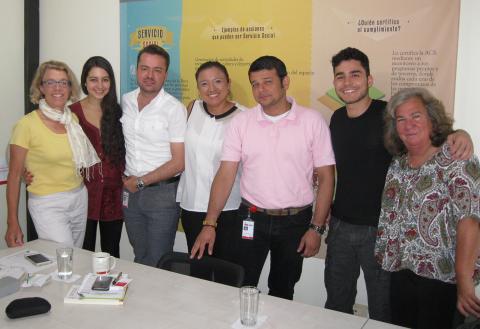
Left: Cindy Albert Link and Ana Maria Villa; center: Diego Julián Jones Navas, Juliana A. Hernandez Cortes, and Edwin Moreno Lozano, of ACR; right: Esteban Roa and Karen Wacks
Mark Small
Our cab wends its way along the dusty winding road leading out of the tiny airport in Ibagué, Colombia toward the city center. The car windows frame the landscape, scenes of grassy fields interspersed with clusters of humble, single-story masonry homes with tile or rusty corrugated metal roofs. There are also farm women and shirtless men hawking fruits and vegetables from tables barely off the road’s shoulder, and feral dogs meandering in search of scraps of food or shade from the blazing July sun. The panorama is underscored by a soundtrack of Spanish-language songs on the cab’s crackling radio speaker, hot wind rushing through the open windows, and a steady road buzz frequently punctuated by the honking horns of impatient fellow travelers.
The scenario morphs as we approach Ibagué’s city center with its busy streets choked with darting motorbikes, cars, trucks, city buses, and steel-nerved pedestrians. Old-world bodegas, butcher shops, sidewalk bakeries, car repair shops, and other humble establishments abut blocks with more modern restaurants and malls. The cab jerks to a stop in front of Ibagué’s Hotel Dulima, where Berklee’s senior vice president for institutional advancement, Cindy Albert Link; music therapy professor, Karen Wacks; and I are to meet with Berklee students Ana Maria Villa and Esteban Roa.
Here in Ibagué, dubbed “La Ciudad Musical de Colombia” (the musical city of Colombia), Villa and Roa—two music therapy (MT) majors and Colombian nationals—have come to gain hands-on experience in a five-week field study. The goal is to assess the role MT can play in helping with the country’s deepest social problem: knitting together the fabric of Colombian society torn through years of brutal internal conflict. Wacks, who designed activities for these experiential-learning efforts, is here to observe her students. She and Link will also discuss with staff members of the Agency for Colombian Reintegration or ACR, future possibilities and logistics for Berklee-trained music therapists to help in the reintegration efforts.
A History Lesson
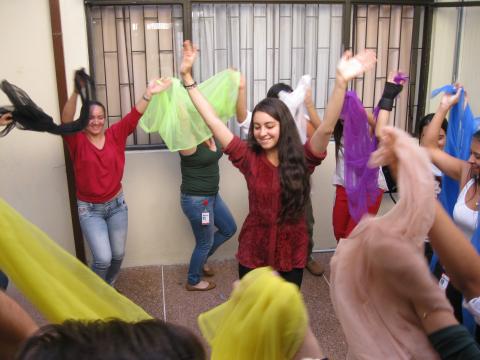
Ana Maria Villa (center) leads a scarf dance activity.
Mark Small
For five decades, civil war has scourged Colombia. According to Colombia’s National Center for Historical Memory, more than 220,000 people (most of them civilians) have been killed in the conflict. Peace negotiations between the Colombian government and FARC (Revolutionary Armed Forces of Colombia), the country’s largest left-wing guerilla group, have been ongoing in Havana since November 2012. The primary struggle waged by the FARC revolutionary Marxists against the Colombian government became very complicated when other combatants entered the fray. They include paramilitaries opposed to FARC and criminal entities battling for domination of Colombia’s cocaine trade. The turmoil has resulted in some 7 million Colombians petitioning the government for status as victims of the war. They include those displaced by the fighting, kidnap victims, families of the disappeared, and those wounded by landmines or otherwise directly injured by the violence. In anticipation of a peace accord, the Colombian government established ACR, an initiative to reintegrate into society the ex-combatants and civilian victims of the conflict. Sadly, many Colombian youths in poverty-stricken neighborhoods join the paramilitary groups just as their contemporaries in other countries might join gangs or ISIS.
Berklee’s involvement with ACR began in 2012 when five members of a Berklee team were in Bogotá conducting auditions and interviews. They met with Alejandro Eder, the executive director of ACR, about the possibility of a collaboration with Berklee’s MT Department. Link, Wacks, and vice president for enrollment Mark Campbell returned for subsequent meetings with ACR staff members and ex-combatants in Ibagué and Bogotá. Those discussions paved the way for another visit in 2013 by Link, Wacks, and assistant professor Kimberly Khare for MT presentations and a training workshop for facilitators of the “Soy Capaz” (“I Can”) project. (The Soy Capaz campaign has enlisted top Colombian celebrity athletes and musicians, along with leaders from education, business, and religious groups to help with the reconciliation efforts.) This exchange of ideas provided the Berklee contingent with insights into ACR and its process and led directly to the five-week field study that Wacks designed with Villa and Roa.
In October 2014, after VIlla performed at the Music Therapy Global Symposium, Wacks shared details of the emerging Colombia project with Villa. She told Wacks to sign her on for the project.
“I love music and I love my country,” Villa told me in July after lunch at Hotel Dulima. “I didn’t know about ACR and their reintegration project until recently. I think it represents something very positive as we seek peace. So many people here are struggling to get onto the right track so that we can all live harmoniously.”
“I’d had an interest in coming back to Colombia,” Roa says, “when Karen [Wacks] talked to me about this initiative. I felt that it was extremely important for Colombian students to be part of it because we are familiar with the conflict and know the culture.” Roa was well prepared for the exploratory project in that much of the research he has done for his MT classes has focused on helping those suffering from PTSD and other effects of war.
ACR’s reintegration program was created for ex-combatants who have not committed crimes against humanity or violations of international humanitarian laws and are seeking to re-enter Colombia’s economic and social life. All participants have to be officially certified as demobilized from illegal armed groups. They are offered such benefits as access to education, job training, psychosocial support, and limited financial aid. Those in the program must commit no offenses after demobilization and participate in 90 percent of the activities scheduled by ACR (including the MT sessions conducted in July by Villa and Roa).
“The five-week program was designed to provide insights and recommendations and act as a foundation for including music therapy services in ACR’s reintegration process in the future,” says Wacks. “For its part, ACR will arrange future internship opportunities for Berklee music therapy students, and the Music Therapy Department will provide the best possible recommendation to ACR on how to incorporate and design a music therapy program within their reintegration process. ACR would also hire music therapists to lead and facilitate the program.”
The five-week program is a component of a wider collaborative project that is connecting Berklee to the MT community in Colombia and ACR, as well as to non-governmental agencies such as Mercy Corps to help sustain and expand the work.
Music Therapy in Action
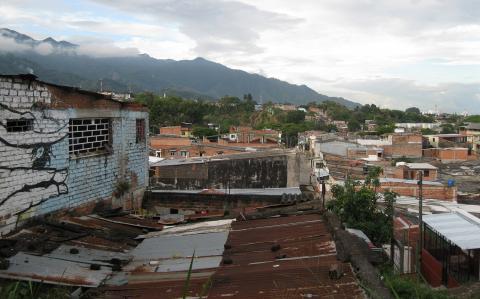
South Ibagué, Colombia
Mark Small
By the time the five of us from Berklee met up in Ibagué in late July, Villa and Roa had been conducting MT sessions with demobilized warriors and victims at Ibagué’s ACR building for more than a month. Their efforts to rebuild a sense of community through interactive MT activities were clearly working at the session Wacks, Link, and I observed. It began with a drum circle as participants entered the room. Each picked up a hand drum or percussion instrument, and played along to an established rhythm for several minutes. Icebreaking activities continued as Villa and Roa playfully introduced the members to each other. Seated close together in a circle, the participants were instructed to ask the name of those to their left and right. The names were then sung to a simple melody in call-and-response style, first by the introducer and then echoed by all. Other group-singing and rhythmic-clapping activities loosened up the crowd to the point that soon, most were smiling.
In one activity during the hour-long session, Villa and Roa led the game Tingo Tango (similar to wonderball) where a ball is passed around as music plays. The person holding the ball when the music stops draws from a pack of cards that poses simple questions, such as, “If you were to go to a desert island, what would you take with you?” One young girl said that she’d take only friends and family to the island while others mentioned a range of material items. Through further interactions, the participants began sharing with the group more personal insights regarding their lives. During a directed meditation as ambient music played, Villa calmly recited thoughts for all to ponder with their eyes closed. After more group singing to well-known songs, the session culminated with a scarf dance. Led by Villa, the participants danced gracefully waving their arms, the whole group linked together by holding opposite ends of chiffon scarves.
“It was quite confirming to witness how quickly music uplifted the human spirit, created a safe container for expression and helped to humanize the individuals and the community as a whole,” Wacks observed. “Esteban’s and Ana Maria’s comfort with the population and familiarity with music and the culture enabled the participants to build trust quite quickly—that’s the cornerstone of any therapeutic process. The participants appeared to be relaxed, refreshed, and hopeful as they left.”
“The reactions of the participants and the way we’ve connected during these sessions is powerful,” Villa says. “The energy we put out comes back amplified by the participants.” “Feeding off their energy is very important,” Roa added. “I’ve learned that there is a performance aspect to what we do. The facial expressions that we put forward and the energy that we give and receive from participants really drive the session. From there, we can improvise to best fit the objectives of those we’re working with.”
Feedback Loop
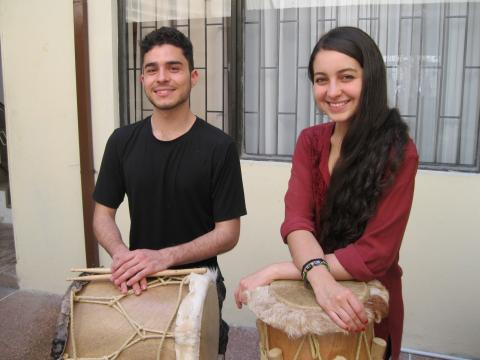
Esteban Roa and Ana Maria Villa
Mark Small
“We have had great classes and supervisors at Berklee,” Villa says, “but when we got here it was time to just go and do it. Being in the situation is one of the best ways to learn. We get to see right away what works and what we have to adjust. Even when you’re working with the same group of patients, they will be different from day to day. Their needs change according to what is going on in their lives. So you can have a plan and a structure, but if it isn’t working you need to have the tools to adjust for what’s required at the moment.”
“We are still students,” Roa adds. “We haven’t finished our training yet so we are out of our comfort zones. My [Berklee] advisor told me to welcome chaos because that’s when you will learn the most. We had a protocol and many things planned, but then everything changed. The people at ACR took our plan apart, and we had to be flexible.”
The nature of the service Villa and Roa were providing to the re-entrants was often cathartic for all parties. “There was one person trying to reintegrate into society,” says Villa. “She came to the sessions and really enjoyed them, but didn’t express herself very much with the group. I saw a transformation in her. She’d been somewhat shy in the session—even while participating. But then afterwards she would tell me or Esteban something very big and personal that comes from deep inside her. I feel we made a big connection with her.”
The overarching mission of ACR is to enable the nation’s entire population to progress on a path toward peace. Components of the strategy to achieve this goal include advising demobilized persons on how to access legal and social benefits and to gain the skills needed to enable them to become productive participants in Colombian society. ACR anticipates providing services for six and a half years before a participant can realize full reintegration. They have noted that MT has the potential to drastically reduce that timespan.
“The reintegrators emphasize that it takes a while for the people to open up and talk about past issues,” Roa states. “In the second session we did, there was an activity that opened up a huge box. People started sharing very personal, heavy things. Later I found out that this is unusual. The music has created a safe space for them to express themselves. One person had gone through some very harsh circumstances—which I‘m not permitted to talk about. But she made a connection with her daughter through some of the songs. She expressed things with the rest of the group, even though they were all strangers.”
“We were all strangers before the music,” Villa adds. “The participants didn’t know us. But then for one hour we were able to really connect. People were trusting and shared a lot of things that were very important to them and have affected their lives. It was huge.”
Toward the Future
ACR has great interest in the healing power of music. During our visit, Edwin Moreno Lozano, an ACR case worker, brought us to the mean streets of South Ibagué. There, Lozano serves 250 re-entrants living in a place where deadly violence is routine. He introduces us to three altruistic and fearless young men who are part of “La Eskina del Barrio” (“The Corner of the Neighborhood”), a pioneering hip-hop initiative that offers positive alternatives for local adolescents who feel hopeless. La Eskina works out of a tiny basement recording studio in a small brick house fortified with steel bars covering every door and window.
Roa translates as the group’s leader Mauricio Rodriguez, describes their outreach. He speaks of how La Eskina’s uses the appeal of hip-hop culture (music, dance, and graffiti), to produce live music and dance concerts, videos, songwriting and production workshops, and support graffiti artists who paint upbeat messages around the neighborhood. Their mission is a grassroots effort to transform their neighborhood by turning young men away from the pervasive culture of violent crime and drugs and young women away from prostitution. Their efforts have resonated deeply with many thousands of young people.
Watch a short video presentation about La Eskina del Barrio:
Back at ACR, Diego Julián Navas, a program director, tells Wacks of his optimism that MT can help with treatment of PTSD and mental illness. He is interested in having ACR’s staff of caregivers learn the methodologies Berklee has developed. He also hopes that MT will benefit ACR’s caregivers who may become overwhelmed with the magnitude of the task before them.
Canaries in the Coalmine
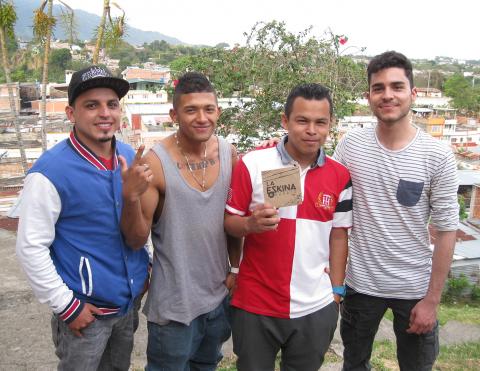
Left to right: Camilo Sanabria, Oscar Rivera, and Mauricio Rodriguez, founders of la Eskina del Barrio
Mark Small
Wacks hopes that the work begun in Colombia can serve as a model that can be replicated globally. She foresees opportunities for Berklee students to learn to provide culturally appropriate care and understand culturally influenced health behaviors and how MT can help.
Villa and Roa were the proverbial canaries in the coalmine during this field study about the possibilities of MT and Berklee’s future involvement in Colombian reintegration work. They took up the task enthusiastically, given their Colombian roots and hunger for practical experience as therapists. In addition to having music and MT skills, this work requires that a person be compassionate and outgoing. Both Roa and Villa possess these qualities in abundance.
Roa was born in Colombia and lived in the country until age five. His family then moved about between London, Miami, and New Jersey before returning to Colombia during his early teen years. Consequently, he speaks Spanish and English with no discernable accent in either tongue. His skill as a translator was invaluable during the meetings Wacks and Link held with ACR representatives and in countless other interactions in Ibagué and Bogotá. He is pursuing a double major at Berklee in MT and Music Business/Management.
“I’ve always been around music,” he says. “My mom played guitar and sang folkloric songs and she started me out with piano and singing lessons. But when my father took up drumming, I sat in on his lessons and quickly turned to the drumset.” While living in New Jersey, Roa played in his school’s orchestra, jazz band, and percussion ensemble and felt fully at home in American culture. “When I moved back to Colombia at 13, my heritage was here but my mind was somewhere else,” he says. “Through drumming, I met some of my best friends in Colombia. We had a band and played songs by Arctic Monkeys and Franz Ferdinand. That helped me know who I was.
“At Berkee, I am a drum principal, so hand percussion is a big tool for me in music therapy. I am involved in other projects, but what really motivates me is what we’ve done during this [project in Ibagué]. I think my musical involvement in the future will be in providing music as a service through music therapy. I see myself going to the field, evaluating, and doing research for music therapy.”
Villa is the eldest of three daughters. Her father, a psychiatrist and mother, a psychologist, raised the family in Bogotá. “My father plays guitar and sings and my grandfather was an opera singer,” Villa tells me. “So I was surrounded by music as a child.” At 12, she began music and dance lessons and later joined a Bogotá music theater company where she learned to integrate dancing, acting, and singing. Coincidentally, she first met Roa there when both were participating in a musical production.
“Music has been my strength throughout my life, so I knew I wanted to be a musician. My piano teacher encouraged me to audition for Berklee. I was accepted and started in the summer of 2013.” Owing to her parents being professional counselors and her dedication to music, majoring in MT—once she became aware of it at Berklee—was a natural. She’s pursuing a double major in performance and MT.
“I am primarily a Latin singer and really enjoy performing,” she says. “I am trying to find a way to balance both music therapy and performance. I see both of them in my future. After graduating I’d like to come back to Colombia. Music therapy doesn’t [yet] have the power here that it has in the United States. I want to see it grow here—the country really needs it. If I could be part of that initiative, it would be great.”




